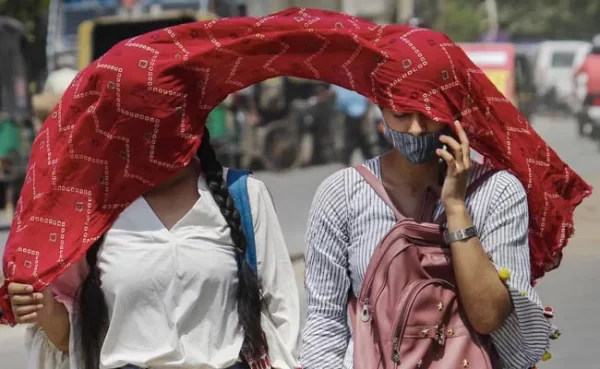Heatwaves in India have become extra common and excessive because of weather extrade, with over ninety percentage of the united states withinside the “extraordinarily cautious” or “risk zone” in their affects, in step with a brand new examine.
The examine, performed via way of means of Ramit Debnath and associates on the University of Cambridge, additionally discovered that Delhi is especially at risk of excessive heatwave affects, aleven though its latest country motion plan for weather extrade does now no longer mirror this.
It counseled that heatwaves have impeded India`s development in the direction of reaching the United Nations’ Sustainable Development Goals (SDGs) extra considerably than formerly thought, and that the present day evaluation metrics won’t absolutely seize the affects of heatwaves connected to weather extrade at the united states.
Heatwaves claimed extra than 17,000 lives in 50 years in India, in step with a paper authored via way of means of M Rajeevan, former secretary of Ministry of Earth Sciences, in conjunction with scientists Kamaljit Ray, S S Ray, R K Giri and A P Dimri.
The paper posted in 2021 stated there had been 706 heatwave incidents withinside the united states from 1971-2019. Thirteen humans died from heatstroke at a Maharashtra authorities award characteristic in Navi Mumbai on Sunday, making it one of the maximum loss of life tolls from a unmarried heatwave-associated occasion withinside the united states’s history.
To investigate India’s weather vulnerability and the capacity effect of weather extrade on SDG development, researchers on the University of Cambridge performed an analytical assessment of the united states’s warmness index with its weather vulnerability index. The warmness index (HI) is a degree of ways warm it feels to the human body, thinking of each temperature and humidity. The weather vulnerability index (CVI) is a composite index that makes use of diverse signs to account for socioeconomic, livelihood, and biophysical elements to examine the effect of heatwave.
The researchers accessed a publicly to be had dataset on country-stage weather vulnerability signs from the authorities’s National Data and Analytics Platform to categorise severity categories. They then as compared India’s development in SDGs over 20 years (2001-2021) with excessive weather-associated mortality from 2001-2021.
The examine confirmed that extra than ninety percentage of India is withinside the “extraordinarily cautious” or “risk” variety of heatwave affects via HI, in any other case considered “low” or “moderate” vulnerability via CVI. States that had been categorised as “low” in CVI scores had been located to be in “risk” HI categories, indicating that heatwaves placed extra humans at excessive weather danger throughout India than predicted via way of means of CVI.
The authors concluded that using CVI may also underestimate the real burden of weather extrade regarding warmness, and counseled that India ought to take into account reassessing its weather vulnerabilities to satisfy the SDGs.
They warned that if India fails to deal with the effect of heatwaves immediately, it is able to sluggish development in the direction of reaching sustainable improvement goals.
The examine additionally highlighted that the present day warmness-motion plans designed and carried out in step with the Delhi authorities’s vulnerability evaluation do now no longer encompass HI estimations, that’s regarding given that even the “low” weather-susceptible regions in Delhi are at excessive heatwave dangers.
The excessive depth of improvement in Central, East, West, and North-East districts can similarly raise the HI dangers via warmness island formation, it stated. The authors stated a number of the vital variables in Delhi with a view to irritate warmness-associated vulnerabilities encompass attention of slum populace and overcrowding in excessive HI regions, loss of get entry to to primary services like electricity, water and sanitation, non-availability of on the spot healthcare and fitness insurance, negative circumstance of housing and grimy cooking fuel (biomass, kerosene and coal).
The threshold for a heatwave is met while the most temperature of a station reaches at the least forty levels Celsius withinside the plains, at the least 37 levels Celsius in coastal regions, and at the least 30 levels Celsius in hilly regions, and the departure from regular is at the least 4.five levels Celsius.
Earlier this month, the India Meteorological Department anticipated above-regular most temperatures for maximum components of the united states from April to June, besides components of the northwest and the peninsular regions.
Above-regular heatwave days are anticipated in maximum components of central, east, and northwest India in the course of this period. In 2023, India skilled its most up to date February given that record-maintaining commenced in 1901. However, above-regular rainfall in March stored temperatures in check.
March 2022 turned into the warmest ever and the 0.33 driest in 121 years. The 12 months additionally noticed the united states’s 0.33-warmest April given that 1901. In India, approximately seventy five percentage of workers (round 380 million humans) revel in warmness-associated stress. A file via way of means of the McKinsey Global Institute warns that if this continues, via way of means of 2030, the united states should lose among 2.five percentage to 4.five percentage of its Gross Domestic Product (GDP) in line with 12 months.




